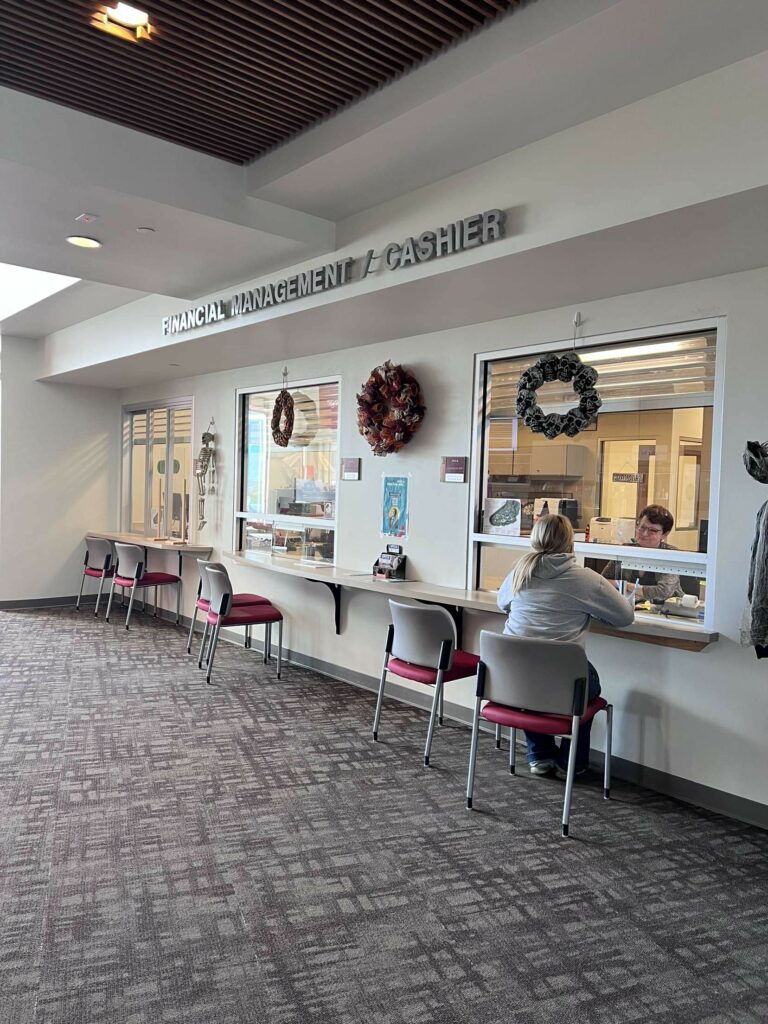
Connie Brooks is pictured here helping Casper College student Ceara Moffatt with financial questions in the Gateway Building.
By Kassadee Lym
Casper College students pay large sums of money to the institution each semester, and the money is distributed to fund various aspects of the college. The Chinook investigated how tuition and mandatory student fees are decided and where the money goes.
Lynnde Colling, vice president of administration at CC, explained the allocation of received funds and where they come from. She also explained the structure of the operating budget at the college, which classifies into three main categories: state appropriations, local appropriations, and tuition and fees.
Colling said that state appropriations are money the college receives from the state, whereas local appropriations are money the college receives from local property taxes. Colling said one challenge the college must navigate when dealing with both sections of the budget is fluctuation. Because of the mineral industry and other variables in the state of Wyoming, Colling said, “ It’s (the budget) is not necessarily flat. It’ll have big ups and downs.”
Colling also explained that steady inflation increases the price of medical supplies, equipment, and technology software. However, the operating budget of CC remained relatively steady.
Colling shared another example of a budget challenge that occurred in 2021. CC’s operating budget saw a two-million dollar shortfall. To deal with this, Colling explained that she and her team worked to refigure the budget to avoid cutting any piece entirely.
“It’s not easy to do quickly, so you have to be looking ahead at the what-ifs,” Colling said.
Tuition and fees make up the last segment of the operating budget.
Colling explained that the Wyoming Community College Commission fixes tuition. The commission works together to decide a set tuition rate for all accredited community colleges in the state based on several statistics and how the state compares with others in the region.
Colling said, “They (the commission) put a lot of focus on affordability and accessibility for students.”
She further explained that the commission will maintain the in-state tuition price until fiscal year 2025.
In terms of fees, Colling explained that mandatory student fees vary by college. She said CC ranks second in the lowest student fees of the community colleges in the state, behind Eastern Wyoming College.
Hailey McKenzie, CC student and livestock judging team member, explained that cost became one of the biggest factors in deciding to leave her hometown of Jefferson, Ore.
“ This(Casper College) was one of the cheaper junior colleges that I looked at,” McKenzie said.
While student fees at CC are on the lower side, the allocation of the fees differs amongst other colleges as well. Colling said each community college decides the allocation of its student fees.
CC’s mandatory student fees are set at $42 per credit hour. Colling chairs Casper College’s Student Fees Committee, which determines how those funds are split. Student senate President Taylee Siemons represents student involvement on the committee.
Nearly half of the student fee funds (49.19 percent) go to technology support. The smallest portion of student fees is publications. In fiscal year 2024 the fees will rise from no allocation to .36 percent of student fees.
The Casper College Student Senate receives some of the other portions of fees. Student senate prioritizes funding requests from clubs. Student fees are also used to allow student free admission to athletic events. A general course student fee minimizes course fees and supports academic operating budgets.
Klacie Groene, Wyoming resident and fitting and showing club president said, “Student fees allow my club to take cool opportunities.”
Groene mentioned that through student senate funds, her club gets to take a trip to the Cheyenne Livestock Expo to exhibit heifers.
However, Groene is not the only one in this case. Casper College student fees support opportunities for students, and tuition contributes to the CC’s operating budget.

